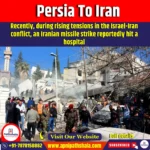| GS Paper 2: Bilateral Groupings and Agreements, Effect of Policies and politics of countries on India’s interests, International Relations |
This editorial, based on “Escalation of West Asia conflict could hurt India” (published in The Hindu Business Line on October 6, 2024), discusses the rising tensions between Iran and Israel. It highlights India’s diplomatic stance, urging restraint and dialogue. The article stresses that a broader conflict could severely impact India’s economic interests, energy security, and regional stability.
Why is West Asia Often Engulfed in Conflicts?
1. Geopolitical Rivalries and Proxy Wars:
Iran and Saudi Arabia are locked in a fierce rivalry, with both aiming to extend their influence across West Asia. This competition manifests through their support of opposing factions in various conflicts.
For example, Saudi Arabia leads a coalition against Iran-backed Houthi rebels in Yemen, which has resulted in a massive humanitarian crisis.
The UN has reported over 377,000 deaths since the conflict began in 2015. Proxy wars have exacerbated the refugee crisis in the region, with 7.2 million Syrians still displaced as of March 2024.
Israel also perceives Iran as a threat due to its nuclear ambitions and support for Hezbollah, leading to ongoing tensions, cyberattacks, and airstrikes.
2. Religious Sectarianism and Identity Conflicts:
The Sunni-Shia divide is a major factor fueling violence in the West Asia region, with 85% of the population being Sunni and 15% Shia. Iran and Saudi Arabia symbolize these sectarian factions.
Iraq saw nearly half a million deaths as a result of the U.S.-led invasion between 2003 and 2011, and sectarian strife continues in Bahrain, where the Sunni monarchy suppresses the Shia majority, particularly since the 2011 Arab Spring uprisings.
3. Abundance of Oil and Resource Control:
West Asia holds around 48% of the world’s proven oil reserves, making control over these resources a focal point for conflict. Wars like the Iraq-Kuwait conflict were driven by the struggle for oil.
The region’s oil wealth makes it vulnerable to external influence, and decisions by OPEC significantly impact global oil prices. Iran’s threats to close the Strait of Hormuz, a key transit point for the world’s oil, continue to elevate military tensions.
4. Colonial Legacy and Artificial Borders:
Colonial-era agreements, such as the Sykes-Picot Agreement, drew arbitrary borders that neglected ethnic and tribal divisions.
This has caused long-standing instability, with conflicts like the Kurdish fight for autonomy and the Palestinian-Israeli dispute rooted in these artificial boundaries.
Israel’s current siege of Gaza has worsened conditions, with 83% of food aid being blocked from entering.
5. Authoritarian Regimes and Political Repression:
Many West Asian countries are ruled by authoritarian regimes, which often respond to dissent with repression.
The Arab Spring uprisings of 2011 sparked calls for reform, but most governments responded with violent crackdowns.
Russia-backed attacks by the Assad regime in Syria have caused significant civilian casualties, exacerbating the region’s political repression.
6. Foreign Interventions and Military Presence:
The U.S. maintains a strong military presence in West Asia, driven by its strategic interest in oil and stability. U.S. involvement in conflicts like Iraq and Afghanistan has had unintended consequences, such as the rise of extremist groups like ISIL.
Events such as Iran downing a U.S. drone in 2019 exemplify how military interventions continue to fuel tensions.
How Do Issues in West Asia Affect India?
1. Energy Security and Oil Imports:
India relies heavily on West Asia for its energy needs, with the region supplying over 60% of its crude oil imports. Any political instability in the area leads to fluctuations in oil prices, affecting India’s economy.
For example, the current Brent crude prices of USD 80-85 per barrel are already putting pressure on India’s imports.
To mitigate these risks, India has been diversifying its energy sources, including increasing imports from Russia, the U.S., and Latin America.
2. Remittances from the Indian Diaspora:
The Indian diaspora in West Asia, numbering over 8 million, is a key source of remittances for India. In 2021, India received around USD 87 billion in remittances, half of which came from Gulf countries.
Economic slowdowns due to conflicts or policies like “Saudization” in Saudi Arabia could reduce remittance flows, particularly affecting states like Kerala.
3. Trade Relations and Economic Impact:
West Asia, especially the Gulf Cooperation Council (GCC), is one of India’s most significant trade partners, with bilateral trade amounting to USD 161.59 billion in FY 2023-24. Geopolitical tensions could disrupt trade relations, harming India’s export sector and food supply chains in the region.
India’s Comprehensive Economic Partnership Agreement (CEPA) with the UAE may also face obstacles due to regional instability.
4. Maritime Security and Trade Routes:
West Asia’s strategic chokepoints, such as the Strait of Hormuz, are crucial for India’s trade and energy imports. Threats to these waterways, whether from piracy or military conflict, jeopardize India’s maritime security.
Incidents like Iran seizing an Israeli-linked cargo ship with 17 Indian nationals aboard in April 2024 underscore the stakes for India.
5. Terrorism and National Security:
Instability in West Asia has fueled the growth of extremist groups like ISIS and Al-Qaeda, which pose a threat to India’s national security.
The FATF’s recent report highlights the dangers of these groups recruiting in regions like Jammu and Kashmir.
6. Cultural and Religious Ties:
India’s large Muslim population, the third largest globally, is closely connected to West Asia. Events in the region, particularly concerning Islamic holy sites, have domestic implications for India’s socio-political climate.
7. Geopolitical Alignments and Great Power Rivalries:
China’s growing influence in West Asia, particularly through initiatives like the Belt and Road Initiative, is a challenge for India. China’s mediation of the Iran-Saudi rapprochement in 2023 further complicates India’s geopolitical interests in the region. India’s involvement in the I2U2 group (India, Israel, UAE, US) is part of its effort to balance these dynamics, but it faces challenges in maintaining relations with rival nations.
What Should India Do to Balance Its Relations in West Asia?
- Pursue Strategic Autonomy and Non-Alignment:
India should continue its policy of non-alignment, maintaining strong bilateral relations with key West Asian players like Saudi Arabia, Iran, Israel, and the UAE. By avoiding taking sides in regional conflicts, India can navigate these rivalries and enhance its reputation as a neutral and peace-promoting country. - Strengthen Economic and Energy Ties:
India needs to reduce its dependence on West Asian oil by diversifying its energy sources, including boosting its renewable energy capacity. Strengthening trade and investment partnerships with GCC countries in sectors like technology, defense, and infrastructure is also essential. - Expand Diplomatic Engagements and Multilateral Cooperation:
India should continue its active participation in regional multilateral forums, such as the Gulf Cooperation Council (GCC) and the Quad (India, Israel, UAE, U.S.), to reinforce its role as a constructive regional player. Additionally, leveraging forums like I2U2 can help India collaborate on shared interests like food security and clean energy. - Enhance Defense and Security Cooperation:
India should strengthen its naval presence in key maritime routes like the Strait of Hormuz and expand defense ties with West Asian nations through joint military exercises, intelligence-sharing, and counter-terrorism efforts. - Prioritize Energy Security and Renewable Energy Initiatives:
Expanding India’s Strategic Petroleum Reserve and collaborating on renewable energy projects with West Asian countries will help reduce the risks posed by oil supply disruptions. Joint initiatives on solar energy or hydrogen fuel will align with India’s energy diversification goals. - Promote Cultural Diplomacy and People-to-People Ties:
With a large Indian diaspora in West Asia, India must protect its workers’ rights and ensure their welfare through diplomatic engagements. Cultural diplomacy, such as hosting events and festivals, will foster goodwill, while offering educational scholarships can build long-term ties between the two regions.
Conclusion:
India’s strategic interests in West Asia call for a balanced and pragmatic approach. Prioritizing issue-based diplomacy and cooperation will enable India to protect its national interests and contribute to regional stability in a highly volatile environment.\
Explore our Books: https://apnipathshala.com/product-category/books/
Explore Our test Series: https://tests.apnipathshala.com/









